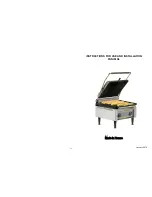
10
| English
Intended Use
The power tool is intended for drilling in wood, metal,
ceramic and plastic, particularly for areas that are hard to
reach. Power tools with electronic control and clockwise/an-
ticlockwise rotation are also suitable for screwdriving and
thread cutting.
Product Features
The numbering of the product features refers to the diagram
of the power tool on the graphics page.
(1)
Rotational direction switch
(2)
Speed preselection thumbwheel
(3)
Chuck key
(4)
On/off switch
(5)
Keyed chuck
(6)
Handle (insulated gripping surface)
Technical Data
Angle drill
GWB 10 RE
Article number
0 601 132 7..
Rated power input
W
400
No-load speed
min
-1
0–1300
Rated speed
min
-1
0–750
Rated torque
Nm
2.2
Chuck capacity
mm
1–10
Max. drilling diameter
– Steel
mm
10
– Aluminium
mm
12
– Wood
mm
22
Weight according to
EPTA-Procedure 01:2014
kg
1.7
Protection class
/ II
The specifications apply to a rated voltage [U] of 230 V. These spe-
cifications may vary at different voltages and in country-specific mod-
els.
Noise/vibration information
Noise emission values determined according to
EN 62841-2-1
.
Typically the A-weighted noise level of the power tool are:
81
dB(A); sound power level
91
dB(A). Uncertainty K =
5
dB.
Wear hearing protection!
Vibration total values a
h
(triax vector sum) and uncertainty K
determined according to
EN 62841-2-1
:
Drilling into metal: a
h
=
2.2
m/s
2
, K =
1.5
m/s
2
Screwdriving: a
h
=
3.0
m/s
2
, K =
1.5
m/s
2
The vibration level and noise emission value given in these
instructions have been measured in accordance with a
standardised measuring procedure and may be used to com-
pare power tools. They may also be used for a preliminary
estimation of vibration and noise emissions.
The stated vibration level and noise emission value repres-
ent the main applications of the power tool. However, if the
power tool is used for other applications, with different ap-
plication tools or is poorly maintained, the vibration level
and noise emission value may differ. This may significantly
increase the vibration and noise emissions over the total
working period.
To estimate vibration and noise emissions accurately, the
times when the tool is switched off or when it is running but
not actually being used should also be taken into account.
This may significantly reduce vibration and noise emissions
over the total working period.
Implement additional safety measures to protect the oper-
ator from the effects of vibration, such as servicing the
power tool and application tools, keeping their hands warm,
and organising workflows correctly.
Assembly
u
Pull the plug out of the socket before carrying out any
work on the power tool.
Changing the Tool
Keyed Chuck
u
Wear protective gloves when changing tools.
The drill
chuck may heat up significantly when it is used for long
periods.
Open the keyed chuck
(5)
by turning it until the tool can be
inserted. Insert the tool.
Insert the drill chuck key
(3)
into the corresponding holes of
the keyed chuck
(5)
and clamp the tool evenly.
Screwdriving Tools
You should always use a universal bit holder when using
screwdriver bits . Only use screwdriver bits that fit the screw
head.
Dust/Chip Extraction
Dust from materials such as lead-containing coatings, some
wood types, minerals and metal can be harmful to one’s
health. Touching or breathing-in the dust can cause allergic
reactions and/or lead to respiratory infections of the user or
bystanders.
Certain dust, such as oak or beech dust, is considered carci-
nogenic, especially in connection with wood-treatment ad-
ditives (chromate, wood preservative). Materials containing
asbestos may only be worked by specialists.
– Provide for good ventilation of the working place.
– It is recommended to wear a P2 filter-class respirator.
Observe the relevant regulations in your country for the ma-
terials to be worked.
u
Avoid dust accumulation at the workplace.
Dust can
easily ignite.
1 609 92A 5CL | (09.10.2019)
Bosch Power Tools











































